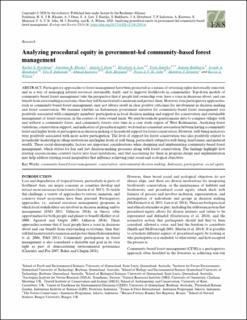Analyzing procedural equity in government-led community-based forest management
Friedman, Rachel; Rhodes, Jonathan; Dean, Angela; Law, Elizabeth; Santika, Truly; Budiharta, Sugeng; Hutabarat, Joseph A.; Indrawan, Tito P.; Kusworo, Ahmad; Meijaard, Erik; St John, Freya; Struebig, Matthew J.; Wilson, Kerrie A.
Peer reviewed, Journal article
Published version

Åpne
Permanent lenke
https://hdl.handle.net/11250/2733832Utgivelsesdato
2020Metadata
Vis full innførselSamlinger
- Publikasjoner fra CRIStin - NINA [2364]
- Scientific publications [1392]
Originalversjon
10.5751/ES-11710-250316Sammendrag
Participatory approaches to forest management have been promoted as a means of returning rights historically removed, and as a way of managing natural resources sustainably, fairly, and to improve livelihoods in communities. Top-down models of community-based forest management take the perspective that if people feel ownership over, have a voice in decisions about, and can benefit from surrounding ecosystems, then they will be motivated to maintain and protect them. However, even participatory approaches, such as community-based forest management, may not always result in clear positive outcomes for involvement in decision making and forest conservation. We examine whether an Indonesian government initiative for community-based forest management was positively associated with community members' participation in local decision making and support for conservation and sustainable
management of forest resources, in the context of state-owned lands. We used household questionnaire data to compare villages with and without a community forest, and community forests over time in a case study region of West Kalimantan. Analyzing forest visitations, conservation support, and indicators of procedural equity, we found no consistent association between having a community forest and higher levels of participation in decision making or household support for forest conservation. However, well-being indicators were positively associated with more active participation. The level of support for forest conservation was also positively related to households' leadership in village institutions and higher levels of well-being, particularly subjective well-being, land tenure, and material wealth. These social-demographic factors are important considerations when designing and implementing community-based forest management, which strives for fair and just decision-making processes along with forest conservation. The findings highlight how existing socioeconomic contexts factor into local institutions, and that accounting for these in program design and implementation may help address existing social inequalities that influence achieving joint social and ecological objectives.